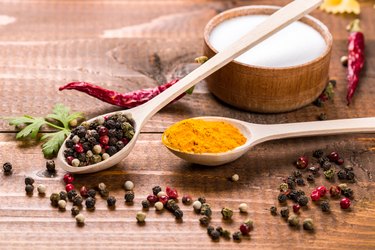
Nine out of 10 Americans take in too much sodium, according to the American Heart Association (AHA). And while we understand that cutting back on salt can help our wellbeing efforts, many of us don't want to compromise the flavor of our food — a caveat that can send us scurrying to find a salt substitute.
Whether your doctor has you on a low-sodium diet to address a particular health condition or you're just trying to cut back, replacing table salt with a salt substitute is one way to reduce your sodium intake. However, many salt substitutes contain potassium chloride — which isn't a healthy option for some people.
Video of the Day
Video of the Day
Why a Salt Substitute Isn't Safe for Everyone
Your body needs a small amount of sodium to function properly. However, too much sodium can lead to health problems, like high blood pressure and increased risk of heart disease and stroke, according to the AHA. In addition, people with certain health conditions, such as kidney problems, may need to cut back on sodium.
Read more: 10 Myths About Salt, Debunked
On average, American adults eat about 3,400 milligrams of sodium per day yet the 2015–2020 Dietary Guidelines for Americans recommend getting less than 2,300 milligrams each day. In turn, many people trying to cut their intake of the salty stuff turn to salt substitutes that contain potassium chloride instead of table salt, which is made of sodium chloride.
And that's not necessarily a bad thing: Potassium chloride is a source of potassium, an electrolyte that most people don't get enough of in their daily diets. In fact, in May 2019, the Food and Drug Administration (FDA) issued a draft guidance stating that food manufacturers could start labeling the compound "potassium chloride salt" to encourage its use as a replacement for sodium chloride. This may help people cut down on over-consumed sodium and dial up on under-consumed potassium, the agency noted.
However, opting for potassium chloride isn't the best route for everyone. People with advanced kidney disease and those who are at increased risk for hyperkalemia, or abnormally high potassium levels, should avoid potassium chloride, says Daniel E. Weiner, MD, FASN, an associate professor at Tufts University School of Medicine and a member of the American Society of Nephrology's Quality Committee.
"People with diabetes may be prone to hyperkalemia as well. Some medications may also predispose people to hyperkalemia, including ACE inhibitors, angiotensin receptor blockers and mineralocorticoid receptor blockers [which are often used to treat blood pressure]."
Ask your health care provider if using a salt substitute with potassium chloride can put you at risk of dangerously high potassium levels.
Other Salt Alternatives Beyond Potassium Chloride
Because potassium chloride is the most commonly used salt substitute, finding one without it can be challenging. Look for those labeled "potassium-chloride free" if you're trying to avoid it. And remember that salt substitutes without potassium chloride typically contain some sodium, but at lower amounts than in table salt.
You can also explore options outside of traditional salt substitutes, such as these iron-rich seaweed options:
Tip
Seaweed (including kelp) contains some naturally occurring sodium, so be sure to check nutrition labels before buying.
And by seasoning your food with strongly flavored spices and herbs, you may find you don't miss salt as much. Try:
- Onion
- Garlic
- Oregano
- Cayenne pepper
Finally, keep in mind that table salt added to home-cooked meals is not the biggest contributor to Americans' high sodium intake. Rather, more than 70 percent of the sodium we take in comes from restaurant meals and processed and packaged foods, especially grains, baked goods and meats, according to the Centers for Disease Control.
So if you're trying to cut back on sodium, be sure to read nutrition labels carefully. And try to get most of your calories from whole foods, such as fruits, vegetables, nuts and legumes.
Read more: 5 Creative Ways to Flavor Food — That Aren't Spices
- University of California-San Francisco: "Guidelines for a Low Sodium Diet"
- U.S. Department of Health and Human Services and U.S. Department of Agriculture: "2015 – 2020 Dietary Guidelines for Americans"
- Centers for Disease Control and Prevention: "Get the Facts: Sodium and the Dietary Guidlines"
- Food and Drug Administration: "FDA Issues Draft Guidance Regarding Use of an Alternative Name for Potassium Chloride in Food Labeling"
- American Heart Association: "Effects of Excess Sodium Infographic"